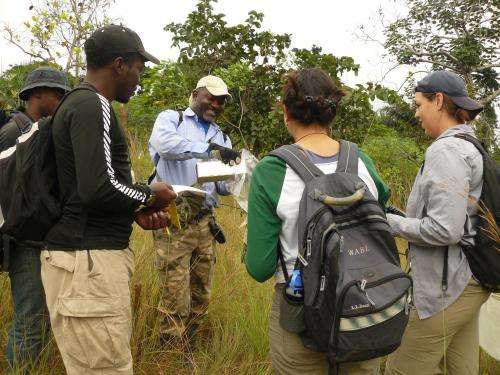Scientists to use research and education to guide conservation in central Africa

Researchers from Africa, North America and Europe have published a road map on how future evolutionary research and education efforts in Central African forests can guide conservation strategies and actions.
A newly published article authored by scientists from the University of Science and Technology of Masuku (USTM), The University of New Orleans, the Wildlife Conservation Society, and other groups outlines a series of scientific and education priorities for the region. The review—now appearing in a recent edition of the journal Biotropica—is the result of a 2011 international workshop held at USTM in Gabon to explore a number of questions on the conservation challenges faced by the region.
The forests of central Africa are one of the most important global centers of tropical biodiversity but face increasing pressure from logging, mining, agricultural development and projected climate change. Among the questions addressed by the authors of the study are: where are the greatest gaps in our understanding of the biodiversity in these forests? What drives patterns of species diversity across the region? Can we make predictions about species' capacity to react to present and future environmental changes?
"Although rarely placed at the forefront of conservation, preserving the natural processes that give rise to evolutionary change is a fundamental strategy for biodiversity conservation," said Dr. Nicola Anthony of the University of New Orleans, one of the lead authors of the review.
"Novel methods to sequence the entire genome of organisms are also opening new doors in biodiversity research, enabling researchers to study genetic adaptation in ways that were never possible before."
Recommendations from this meeting came out of six major working group documents that examined: (1) What biodiversity exists and how scientists can best document it? (2) What causes evolutionary diversification? (3) How do researchers monitor environmental change and why is this important? (4) How can evolutionary tools be used to understand community and ecosystem-level processes? (5) What do scientists know of evolutionary epidemiology? (6) What are the needs and priorities for higher education in the region?
Several major wide-ranging priorities were clear. First, more efforts are needed to survey and sample areas that have traditionally received little attention, especially in the interior of the Congo basin. Efforts are also needed to build larger, more comparative datasets and boost expertise in taxonomic groups that remain poorly understood.
Secondly, novel genetic methods should be employed to better understand the history and evolution of the region's biodiversity. These same tools can also be used to assess how animal and plant population may be able to respond to current and future threats. Standardized monitoring programs can also be used in concert with these methods to track impacts of environmental change and develop appropriate response strategies, particularly important for tropical species likely to be affected by climate change.
Lastly, while institutions of higher education across the region face considerable challenges, they are ideally positioned to play a pivotal role in training the region's next generation of biodiversity scientists. Expanding training to meet national priorities in natural resource management, assessing the legacy and impact of external collaboration and focusing investment in better cyber-infrastructure and professional development were also identified as important priorities for the future.
"The maintenance of national, high-level conservation science training, and long-term monitoring of wildlife and threats is essential for maintaining Central Africa's vast, unique, and in many places largely intact wild places" says Dr Fiona Maisels, a co-author and WCS conservation scientist who worked in the region for over two decades. "Ongoing financial and resources commitments from the Central African nations and the international community are vital to ensure that successive generations of African scientists are trained, funded, and employed in the field of wildlife conservation".
More information: "Evolution and Conservation of Central African Biodiversity: Priorities for Future Research and Education in the Congo Basin and Gulf of Guinea" , Biotropica, http://onlinelibrary.wiley.com/doi/10.1111/btp.12188/abstract
Journal information: Biotropica
Provided by Wildlife Conservation Society















